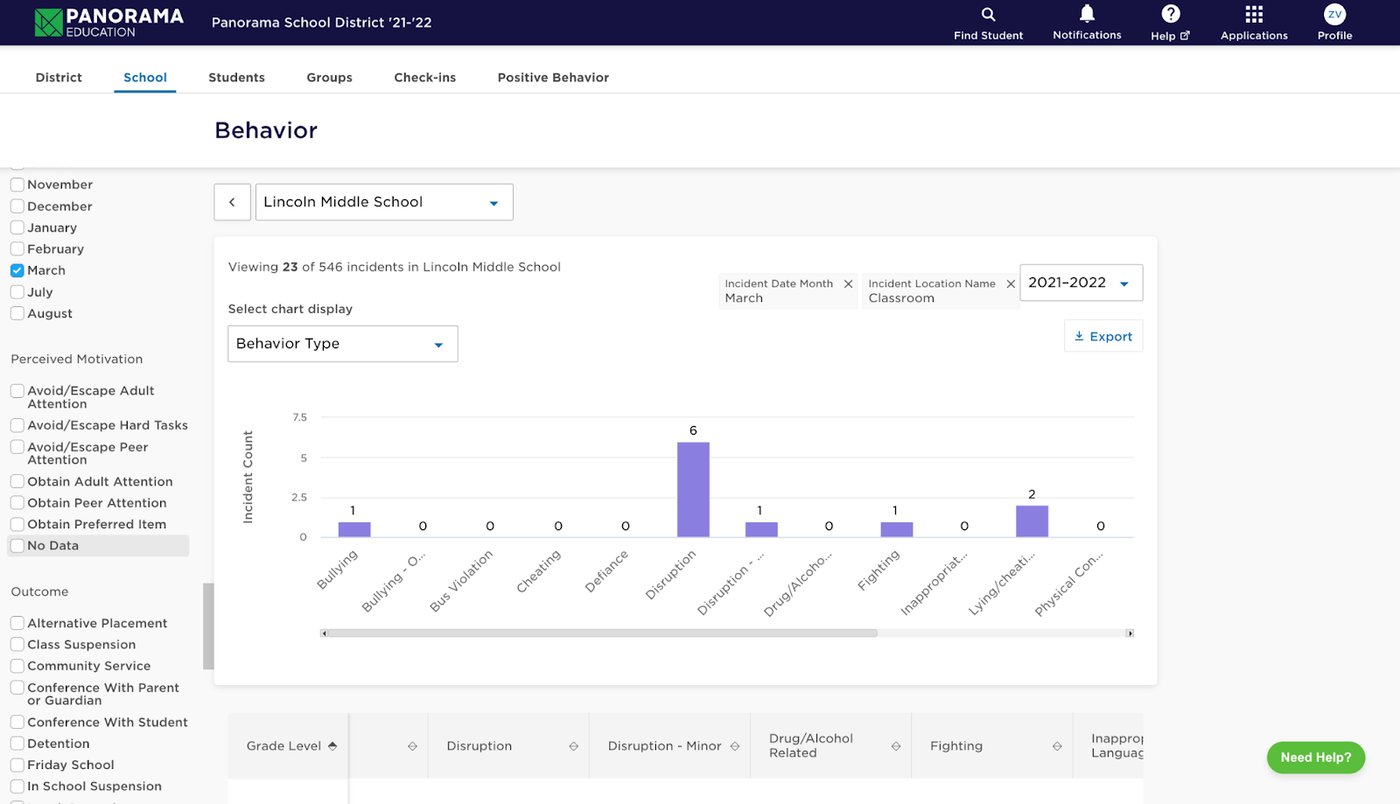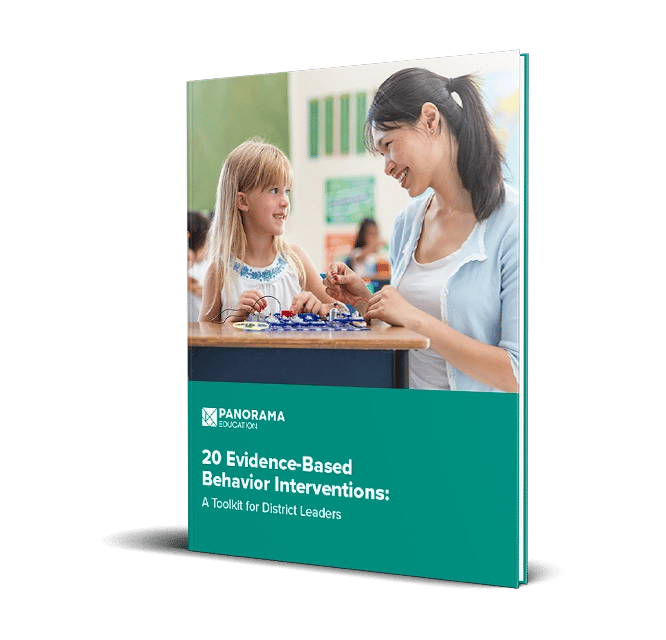In this Intervention Brief, we explore the Check-In/Check-Out Intervention, often called CICO for short. This popular Tier 2 intervention promotes positive behavior. It is often implemented within a PBIS (positive behavior interventions and supports) and/or MTSS (multi-tiered system of supports) framework.
Table of Contents
What the Research Says About Check-In/Check-Out
How to Implement Check-In/Check-Out
CICO Intervention Overview
Check-In/Check-Out (CICO), also known as the Behavior Education Program (BEP), is a Tier 2 evidence-based intervention that addresses common classroom behavior challenges. CICO is an opportunity for a student and an adult champion to work together to improve student behavior.
The strategy works by providing predictable opportunities for educators to teach behavior expectations and provide positive reinforcement (e.g., behavior-specific praise) and feedback. Students may be given tangible reinforcement (rewards or prizes) when they achieve daily goals.
A student receiving CICO meets with adults throughout the school day to reinforce and track behavioral goals. The student "checks in" with the champion first thing in the morning. Throughout the day, teachers provide positive and corrective feedback. Students then "check out" with the champion at dismissal to review their overall behavior that day.
What the Research Says About Check-In/Check-Out
By providing students ample opportunities to receive positive attention from adults, CICO implementation has been shown to produce positive outcomes for students:
- Increased adherence to school-wide positive behavior expectations
- Reduced rates of office discipline referrals (behavior incidents)
- Reduced rates of mild disruptive behaviors
Research also suggests that CICO may result in increased academic engagement and prosocial behaviors.
Studies have found that CICO works best for students with low-level disruptive behaviors, such as calling out or defiance. Students who seek attention benefit most from CICO, since the intervention includes regular, positive attention from adults.

Free Check In Question Template
100+ Questions Across Well-Being, Life Skills, and More!
How to Implement Check-In/Check-Out
Implementing CICO places minimal burden on educators—classroom teachers can typically implement the practice in five to ten minutes per day. Follow these steps to get started with CICO.
1. Identify students who can benefit from CICO
Lean into data-based decision-making when planning a CICO intervention. Look for students with frequent behavior incident reports for disruptive behaviors. Determine if the motivation behind the behavior was to obtain attention from adults. Students who fit this profile may be good candidates for CICO intervention.
Consult your student support teams, grade-level teams, or PBIS teams for additional flags.

Panorama helps teams efficiently identify students with multiple behavior incidents.
2. Create an intervention plan
If CICO seems like a good match for a student's behavioral needs, the student support team creates an intervention plan. Your plan might include information like:
- Student name
- Intervention description
- Goal
- Champion
- Start date
- Duration
- Monitoring method and frequency
A key part of the plan is assigning a champion who is responsible for daily CICO implementation. A champion is the adult who conducts the morning check-in and afternoon check-out. The champion could be a classroom teacher, counselor, coach, or other staff member. The important thing is that the champion is someone who the student trusts and feels comfortable meeting with on a regular basis.
3. Implement the plan
Create a daily progress report for teachers and champions to track how the student performs against their behavior goals. (Get started with our customizable daily progress report templates.)
On a daily basis, successful implementation of the CICO intervention includes:
- Morning Check-In: The student checks in with their champion each morning after arriving at school. The goal of this morning meeting is to review behavioral goals, collaboratively set goals for the day, and provide encouragement.
- Monitoring, Evaluation, and Feedback: Throughout the day, teachers observe the student's behaviors during routine timeframes and fill out the daily progress report. Teachers share feedback with the student at the end of instructional blocks, class periods, or during natural transitions. Feedback should be positive, specific, and corrective when appropriate.
- Check-Out: At the end of the day, the student meets with the champion again to discuss if the student reached the daily goals and target behaviors. If the student met their goals, the champion provides verbal praise and tangible reinforcement—often in the form of points or prizes. If the student did not meet their goals, the champion offers supportive feedback and encouragement.
4. Progress monitor
Student support teams progress monitor the intervention to understand how well it is working. They should ask themselves these key questions:
- Is the intervention being implemented on most days the student is in school?
- Is the intervention helping the student to progress toward, achieve, and surpass goals?
Teams can use the data to make adjustments to the intervention plan as needed or determine if a student is ready to "exit" the CICO intervention.

Educators can visualize a student’s behavior progress through Panorama’s new CICO daily progress report.
|
Frequently Asked Questions: 1. Can the Check-In/Check-Out (CICO) intervention be implemented in virtual or hybrid learning environments? Yes, the CICO intervention can be implemented in virtual or hybrid learning environments by utilizing video conferencing platforms for check-ins and check-outs, electronic progress tracking tools for monitoring, and digital reward systems for reinforcement, ensuring continuity in support regardless of the learning setting. 2. How long does it typically take to see noticeable improvements in student behavior after implementing the Check-In/Check-Out (CICO) intervention? The timeline for seeing improvements in student behavior can vary depending on individual student needs, consistency of implementation, and alignment with other interventions and supports. However, educators may start to observe positive changes within a few weeks to a couple of months of implementing CICO. 3. Are there any potential drawbacks or challenges associated with implementing the Check-In/Check-Out (CICO) intervention? While CICO has been shown to be effective in promoting positive behavior, challenges may arise related to staff capacity for implementation, consistency in monitoring and feedback, and addressing the needs of students with complex behavioral issues. Ongoing training, support, and collaboration among staff members can help mitigate these challenges. |
CICO in Your District
You may already be using CICO to support students in your district. Many districts implement the CICO behavior intervention within MTSS and/or PBIS approaches. It can also be a good fit for any district looking to address routine classroom management needs using proactive tools. Either way, having the right tools to help you implement CICO will mean more benefit to students.
Panorama tools can help identify students who can benefit from CICO, track CICO implementation, and monitor students' progress in the intervention. With Panorama’s interventions interface, educators can spend less time on reporting and focus their attention on students.




.jpg)

![How to Write an Intervention Plan [+ Template]](https://www.panoramaed.com/hubfs/intervention%20planning-1.jpg)
